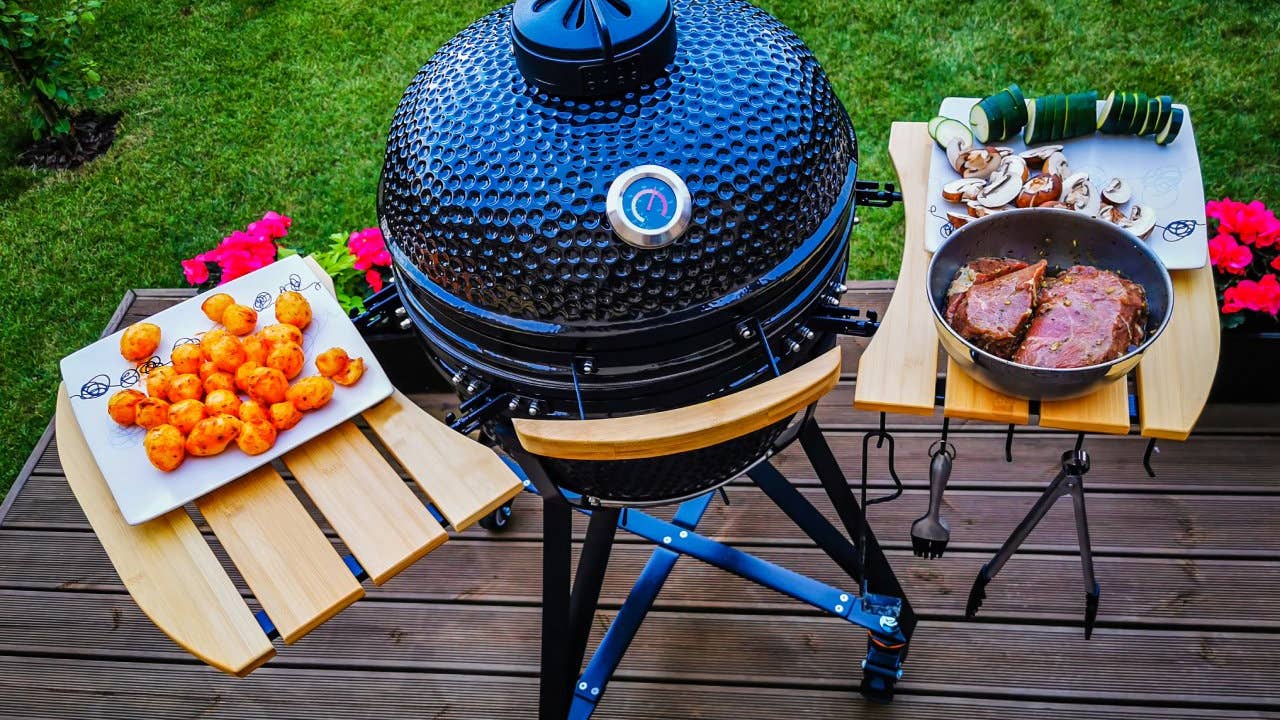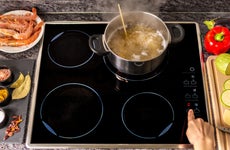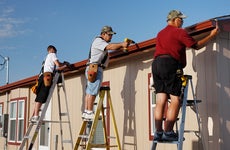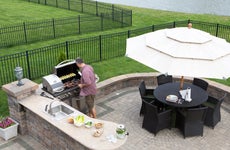A guide to outdoor grills: best choices for backyard BBQs

The Bankrate promise
At Bankrate we strive to help you make smarter financial decisions. While we adhere to strict , this post may contain references to products from our partners. Here's an explanation for .
‘Tis the season to cook and eat al fresco, the season of backyard barbecues and lawn parties. And despite the advent of specialized home appliances (pizza ovens, deep fryers) and full-fledged outdoor kitchens, summertime cooking remains synonymous with two words: outdoor grill.
The most recent Kitchen Audit Study by marketing firm The NPD Group found that 69 percent of U.S. households owned an outdoor grill in early 2020. Since July of that year, U.S. consumers have bought more than 21 million grills and smokers.
But grills have come a long way since the spherical, charcoal-burning devices of old. In fact, there’s quite a variety of types to choose from, not to mention new-fangled bells, whistles and accessories. Here’s a guide to grill trends and buying the best grill for your needs.
Traditional types of grills
Grills are typically categorized by the sort of fuel that powers them. Gas and charcoal options make up two-thirds of the grills sold, according to The NPD Group.
Charcoal grill
Purists often prefer this type of grill, fueled by charcoal briquettes or lump charcoal, for the quintessential char and smoky flavor it imparts to food. On the pro side, charcoal grills are the most affordable, generally ranging from $30-$300 (though you do have the ongoing cost of replacing the charcoal), and they cook fast, since they get very hot. As a con, they take more time to heat up, and require more skill to use — the flames can’t be adjusted and can be difficult to control. Plus, they’re messy: You’ll need to empty the ashes and clean up the bowl and rings, ideally after each use.
Gas grill
Highly popular, gas grills usually come cart-style or built-in. On the pro side, they’re quick to heat and easy to use and clean — not that different from an indoor gas stove or oven. They’re also economical, running from $90 to $1,000 or more, depending partially on the number of burners. Unfortunately, unless you use a smoker box, the food won’t develop that characteristic char or barbecued flavor. If you hook it up to a gas line, you can’t move the grill much. For that reason, some run their gas grills via liquid propane in tanks (which have to be replaced periodically).
Electric grill
Electric grills are ideal for indoor cooking or when HOAs and apartment buildings don’t allow other types of grills. Although they don’t impart a smoky flavor, they’re economical (running from $50-$600) and easy to use and clean. Just remember that you’ll need to plug them into an electrical outlet, which may limit where you can place them.
Wood pellet grill
“The popularity of ‘set it and forget it’ pellet smokers has soared in the last 10 years,” says Steven Raichlen, author of the “Barbecue Bible” cookbook series and host of “Project Fire” and “Project Smoke” on PBS — in fact, they were the fastest-growing type in 2021, NPD data confirms. These grills burn hardwood or sawdust pellets as fuel, with fans circulating heat and smoke to cook food. Simple to ignite and use, pellet grills allow cooks to select precise temperatures and result in serious, woodsy flavor — similar to anything cooked in a wood-fired oven or stove.
Unfortunately, they don’t typically give off as hard of a sear as a gas or charcoal grill, says Paul Sidoriak, author of “The Flippin’ Awesome Backyard Griddle Cookbook” and “Exclusively Kamado.” Plus, they take time to preheat, require the clean-up of ashes and cost $300-$1,800.
Grill trends: new tech and extras
For the latest in grill innovations, consider these options.
Infrared grill
These grills or grill burners feature a solid cooking surface, which cooks food by emitting infrared waves. They heat and cook quickly (with no flare-ups), reach very high temperatures and keep food moist. “Infrared side burners are perfect to sear steaks, creating a juicy restaurant-quality result,” say Maddie and Kiki Longo, Canadian sisters who teach BBQ classes and run the Maddie & Kiki YouTube channel. On the downside, infrared grills are pricey, at $800-$1,500 or more. Plus, as Sidoriak points out, they’re usually small; in fact, they often come as an accessory on gas grills.
Kamado grill
Inspired by traditional Japanese rice cookers, these deep, egg-shaped vessels are fueled by charcoal (or wood). Usually composed of ceramic, they can get very hot and maintain an even cooking temperature. “They are an all-in-one style of grill — you can grill hot and fast, as well as smoke meat low and slow,” say the Longos. On the con side, controlling the heat can be challenging and these grills can take a few hours to cool down. Plus, expect to spend $500 or more.
Portable grill
Many grills come on wheels, making them moveable around the yard or patio. But if you want to take a grill on a road trip, to the beach or to the park, portable grills are the ultimate in practicality. “Portable grills are hot right now, both literally and figuratively,” say the Longos.
Powered by propane or charcoal, portable grills look like mini-me versions of their conventional cousins. “These smaller grills may appear cute and tiny but do not assume they don’t perform as well as the bigger grills. Portable grills are just as powerful,” the Longos note. Of course, they don’t have as big a cooking surface, and they aren’t that much cheaper (ranging from $60 to $300).
Flat top or griddle
“Anyone who has cooked on a stove or in a pan is completely qualified to cook on a griddle,” says Sidoriak. “It’s not intimidating, there’s no open flame.” These grills with large, flat, open cooking surfaces are usually fueled by propane, though there are electric versions as well. Along with letting you cook multiple dishes at once (like scrambled eggs and pancakes), griddles and flat tops provide high, even heat. As a downside, since they don’t have a lid, they’re not appropriate for low and slow cooking/smoking, and of course they don’t provide that ‘cue char and taste. Prices range from $100 to $2,000.
Rotisserie
“A renewed interest in spit-roasting has fueled rotisserie sales,” says Raichlen. “Large free-standing versions can accommodate whole animals such as pigs. Smaller rotisserie units, though often sold separately, are available for many types of grills.” While you can buy a whole separate rotisserie, it often makes more sense to add a rotisserie as an accessory to a charcoal or gas grill.
Rotisseries cook extremely evenly and healthfully, as the fat drips off, leaving just a delicious flavor. Though associated with meat roasts and whole chickens, rotisseries are quite versatile. “I love to grill fruits and vegetables on spits,” Raichlen says. “Some units come with wire baskets, useful for roasting Hatch chiles come August.”
Smart grill
Grill cooking used to be pretty imprecise: “It used to [just] be low, medium or high or a large or small flame,” explains Sidoriak. But now grills have gotten smart. Thanks in part to wireless meat probes and connectivity with Bluetooth and Wi-Fi, some models now allow you to control the temperature from your phone and know when food is ready.
How to choose the right grill
There’s no one perfect grill for everyone. You have to ponder your priorities. To help you choose, here’s a checklist of characteristics that apply to different grill types.
| Characteristics | Grill type |
|---|---|
| Smoky flavor, char | Charcoal, Pellet, Kamado |
| Rewarding cooking challenge | Charcoal |
| Cooking versatility | Pellet, Kamado |
| Ease of use | Gas, Infared, Pellet |
| Economy | Gas, Electric, Charcoal |
| Easiest to clean up | Gas, Electric |
| Heating-up speed | Gas, Infared |
| Lowest maintenance | Gas, Electric |
| State-of-the-art | Pellet, Infared |
| No electrical outlet | Charcoal, Gas |
| Compact | Portable |
If you still can’t decide between grill types, Raichlen suggests investing in two grills or a hybrid like a pellet or dual-fuel grill.
Then, decide on size. “I advise people to buy more grill than they think they’ll need,” says Raichlen. “Someday, they may be called upon to cook ribs or burgers for a crowd and they’ll wish they had another 354 [square] inches of cooking space.”
Once you’ve narrowed down a grill type and size, consider a specific product’s sturdiness, manufacturer reputation and service availability and warranty, adds Raichlen: “The increasing number of high-tech features on many of today’s grills means much can go wrong.”
Related Articles



What’s new in ‘cue? Trends in backyard grills and outdoor cooking
